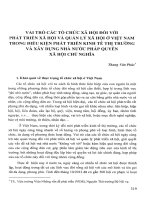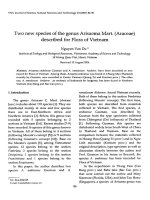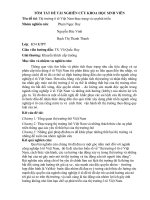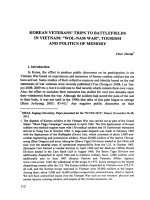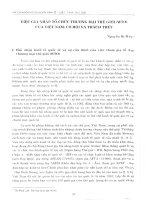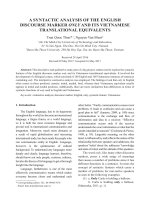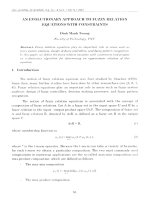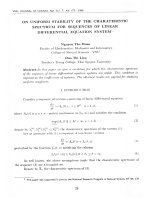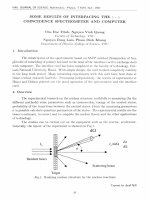DSpace at VNU: Differential Operators Associated to the Cauchy-Fueter Operator in Quaternion Algebra
Bạn đang xem bản rút gọn của tài liệu. Xem và tải ngay bản đầy đủ của tài liệu tại đây (255.92 KB, 15 trang )
Adv. Appl. Clifford Algebras 21 (2011), 591–605
© 2011 Springer Basel AG
0188-7009/030591-15
published online January 4, 2011
DOI 10.1007/s00006-010-0272-2
Advances in
Applied Clifford Algebras
Differential Operators Associated to the
Cauchy-Fueter Operator in Quaternion
Algebra
Thanh Van Nguyen
Abstract. This paper deals with the initial value problem of the type
∂w
∂w
= L t, x, w,
∂t
∂xi
w(0, x) = ϕ(x)
(1)
(2)
where t is the time, L is a linear first order operator (matrix-type)
in Quaternionic Analysis and ϕ is a regular function taking values in
the Quaternionic Algebra. The article proves necessary and sufficient
conditions on the coefficients of operator L under which L is associated
to the Cauchy-Fueter operator of Quarternionic Analysis.
This criterion makes it possible to construct the operator L for
which the initial problem (1), (2) is solvable for an arbitrary initial
regular function ϕ and the solution is also regular for each t.
Mathematics Subject Classification (2010). 35B45; 35F10; 47H10.
Keywords. Initial value problem, associated space, interior estimate.
1. Preliminaries and Notations
Let H be a Quaternion algebra with the basis formed by e0 , e1 , e2 , e3 where
e0 = 1, e3 = e1 e2 = e12 .
Suppose that Ω is a bounded domain of R4 . A function f defines in Ω
and takes values in the Quaternionic Algebra H which can be presented as
3
f=
fj ej ,
j=0
where fj (x) are real-valued functions.
We introduce the Cauchy-Fueter operator
3
D=
ek
k=0
∂
.
∂xk
592
T.V. Nguyen
Adv. Appl. Clifford Algebras
Definition 1. A function f ∈ C 1 (Ω, H) is said to be regular in Ω if f satisfies
Df = 0.
2. Necessary and Sufficient Conditions for Associated Pairs
Suppose that f =
3
j=0
fj ej is a twice continuously differentiable function
with respect to the space-like x0 , x1 , x2 , x3 . Now assume that f is regular.
This means that Df = 0. It is easy to verify that the condition Df = 0 is
equivalent to
3
∂f
Ai
= 0,
∂x
i
i=0
where
⎡
1
⎢0
A0 = ⎢
⎣0
0
0
1
0
0
0
0
1
0
⎤
0
0⎥
⎥,
0⎦
1
⎡
0 −1
⎢1 0
A1 = ⎢
⎣0 0
0 0
⎡
0
⎢0
A3 = ⎢
⎣0
1
We define an operator
0
0
1
0
⎤
0 0
0 0⎥
⎥,
0 −1⎦
1 0
⎤
0 −1
−1 0 ⎥
⎥,
0
0⎦
0
0
⎡
0
⎢0
A2 = ⎢
⎣1
0
⎛ ∂f0 ⎞
0
0
0
−1
−1
0
0
0
⎤
0
1⎥
⎥
0⎦
0
∂x
⎜ ∂f1i ⎟
⎜ ∂xi ⎟
∂f
⎟
=⎜
⎜ ∂f2 ⎟ .
∂xi
⎝ ∂xi ⎠
∂f3
∂xi
as follows,
3
f=
Ai
i=0
∂f
.
∂xi
(3)
It is clear that
⎛Df⎞= 0 if and only if f = 0. Next, we identify the function
f0
⎜f1 ⎟
⎟
f with f := ⎜
⎝f2 ⎠ and introduce a differential operator L as follows,
f3
3
∂f
+ Cf + K,
(4)
∂xj
j=0
⎛ ⎞
d0
⎜d1 ⎟ (j)
(j)
⎟
where Bj = [bαβ ], C = [cαβ ], K = ⎜
⎝d2 ⎠, bαβ , cαβ , dα , (α, β = 0, 1, 2, 3) are
d3
real-valued functions which are supposed to depend at least continuously on
the time t and the space-like x0 , x1 , x2 , x3 . A pair of operators , L is said
to be associated (see [9]) if f = 0 implies (Lf ) = 0 (for each t in case
the coefficients of L depend on t). Now we formulate necessary and sufficient
conditions on the coefficients of operator L under which L is associated to
Lf =
Bj
Vol. 21 (2011)
Differential Associated Operators and Their Applications
593
the operator (in other words, L is associated to the Cauchy-Fueter operator
(j)
of Quaternionic Analysis). Assume that the functions bαβ , cαβ , dα (j, α, β =
0, 1, 2, 3) are continuously differentiable with respect to the space-like variable
x0 , x1 , x2 , x3 and differentiable on t.
Put
(j)
Pj = [pαβ ] = Aj Bj ,
Qij =
(ij)
[qαβ ]
(j)
j = 0, 1, 2, 3
= Ai B j + A j B i ,
Rj = [rαβ ] =
3
Ai
i=0
(5)
0≤i
(6)
∂Bj
+ Aj C, j = 0, 1, 2, 3, α, β = 0, 1, 2, 3.
∂xi
(7)
Then we get the following theorem.
Theorem 1. The operator L is associated to the operator
following conditions are satisfied
i) The functions h(α) =
3
i=0
ciα ei , α = 0, 1, 2, 3, and g =
if and only if the
3
i=0
di ei are regu-
lar.
⎧ (1)
(0)
(2)
(0)
(3)
(0)
⎪ri0 = ri1
, ri0 = ri2 , ri0 = ri3
⎪
⎪
⎪
⎪
(1)
(0)
(2)
(0)
(3)
(0)
⎪
⎪
r = −ri0 , ri1 = −ri3 , ri1 = ri2
⎪
⎨ i1
(1)
(0)
(2)
(0)
(3)
(0)
ii) ri2)
= ri3 , ri2 = −ri0 , ri2 = −ri1
⎪
⎪
⎪
(1)
(0)
(2)
(0)
(3)
(0)
⎪
⎪
ri3 = −ri2 , ri3 = ri1 , ri3 = −ri0
⎪
⎪
⎪
⎩
i = 0, 1, 2, 3.
⎧ (01)
(0)
(1)
(02)
(0)
(2)
(03)
(0)
(3)
⎪
qi0 = pi1 − pi1 , qi0 = pi2 − pi2 , qi0 = pi3 − pi3
⎪
⎪
⎪
⎪
(12)
(1)
(2)
(13)
(1)
(3)
(23)
(2)
(3)
⎪
⎪
⎪qi0 = −pi3 + pi3 , qi0 = pi2 − pi2 , qi0 = −pi1 + pi1
⎪
⎪
⎪
⎪q (01) = −p(0) + p(1) , q (02) = −p(0) + p(2) , q (03) = p(0) − p(3)
⎪
⎪
i1
i0
i0
i1
i3
i3
i1
i2
i2
⎪
⎪
⎪
(12)
(1)
(2)
(13)
(1)
(3)
(23)
(2)
(3)
⎪
⎪
q
= −pi2 + pi2 , qi1 = −pi3 + pi3 , qi1 = pi0 − pi0
⎪
⎨ i1
(01)
(0)
(1)
(02)
(0)
(2)
(03)
(0)
(3)
iii) qi2
= pi3 − pi3 , qi2 = −pi0 + pi0 , qi2 = −pi1 + pi1
⎪
⎪
⎪
(12)
(1)
(2)
(13)
(1)
(3)
(23)
(2)
(3)
⎪
⎪
qi2 = pi1 − pi1 , qi2 = −pi0 + pi0 , qi2 = −pi3 + pi3
⎪
⎪
⎪
⎪
(01)
(0)
(1)
(02)
(0)
(2)
(03)
(0)
(3)
⎪
qi3 = −pi2 + pi2 , qi3 = pi1 − pi1 , qi3 = −pi0 + pi0
⎪
⎪
⎪
⎪
⎪
(12)
(1)
(2)
(13)
(1)
(3)
(23)
(2)
(3)
⎪
⎪
⎪qi3 = pi0 − pi0 , qi3 = pi1 − pi1 , qi3 = pi2 − pi2
⎪
⎪
⎩i = 0, 1, 2, 3.
Proof. We get
3
∂(Lf )
∂xi
i=0
⎛
⎞
3
3
∂ ⎝
∂f
=
Ai
Bj
+ Cf + K ⎠
∂x
∂x
i
j
i=0
j=0
(Lf ) =
Ai
594
T.V. Nguyen
⎛
3
=
Ai
i=0
3
⎞
3
Adv. Appl. Clifford Algebras
3
3
∂f ⎠
∂(Cf )
∂ ⎝
∂K
+
Bj
Ai
+
Ai
∂xi j=0 ∂xj
∂xi
∂xi
i=0
i=0
3
3
=
Ai B j
i=0 j=0
3
+
Ai
i=0
3
3
∂2f
∂Bj ∂f
+
Ai
∂xi ∂xj
∂xi ∂xj
i=0 j=0
3
∂C
∂xi
3
Ai C
f+
i=0
∂K
∂f
+
Ai
∂xi i=0 ∂xi
2
=
Ai B i
i=0
3
∂ f
+
∂x2i
3
Ai
+
j=0
i=0
(Ai Bj + Aj Bi )
0≤i
∂Bj
+ Aj C
∂xi
∂2f
∂xi ∂xj
3
∂f
+
∂xj
Ai
i=0
(8)
∂C
∂xi
3
Ai
f+
i=0
∂K
.
∂xi
By (5), (6) and (7), then (8) can be rewritten as
3
2Pi
l(Lf ) =
i=0
∂2f
+
∂x2i
3
+
Ai
i=0
Write
∂C
∂xi
3
Qij
0≤i
∂2f
∂f
+
Rj
∂xi ∂xj j=0 ∂xj
3
Ai
f+
i=0
∂K
.
∂xi
(9)
⎛
⎞
m0
⎜m1 ⎟
∂2f
∂2f
⎟
M=
Pi 2 +
Qij
=⎜
⎝m2 ⎠
∂xi
∂xi ∂xj
i=0
0≤i
⎛ ⎞
n0
3
⎜n 1 ⎟
∂f
⎟
=⎜
N=
Rj
⎝n 2 ⎠
∂xj
j=0
n3
3
3
S=
Ai
i=0
∂C
∂xi
3
f,
Ai
T =
i=0
∂K
.
∂xi
Then we obtain
l(Lf ) = M + N + S + T.
We get
2
2
2
f0
(0) ∂ f1
(0) ∂ f2
(0) ∂ f3
+
p
+
p
+
p
i1
i2
i3
∂x20
∂x20
∂x20
∂x20
2
2
2
2
(1) ∂ f0
(1) ∂ f1
(1) ∂ f2
(1) ∂ f3
+ pi0
+
p
+
p
+
p
i1
i2
i3
∂x21
∂x21
∂x21
∂x21
2
2
2
2
(2) ∂ f0
(2) ∂ f1
(2) ∂ f2
(2) ∂ f3
+ pi0
+ pi1
+ pi2
+ pi3
2
2
2
∂x2
∂x2
∂x2
∂x22
(0) ∂
mi = pi0
2
(10)
Vol. 21 (2011)
Differential Associated Operators and Their Applications
2
2
2
f0
(3) ∂ f1
(3) ∂ f2
(3) ∂ f3
+ pi1
+ pi2
+ pi3
2
2
2
∂x3
∂x3
∂x3
∂x23
2
2
2
2
(01) ∂ f0
(01) ∂ f1
(01) ∂ f2
(01) ∂ f3
+ qi0
+ qi1
+ qi2
+ qi3
∂x0 ∂x1
∂x0 ∂x1
∂x0 ∂x1
∂x0 ∂x1
2
2
2
2
(02) ∂ f0
(02) ∂ f1
(02) ∂ f2
(02) ∂ f3
+ qi0
+ qi1
+ qi2
+ qi3
∂x0 ∂x2
∂x0 ∂x2
∂x0 ∂x2
∂x0 ∂x2
2
2
2
2
∂
f
∂
f
∂
f
0
1
2
(03)
(03)
(03)
(03) ∂ f3
+ qi0
+ qi1
+ qi2
+ qi3
∂x0 ∂x3
∂x0 ∂x3
∂x0 ∂x3
∂x0 ∂x3
2
2
2
2
∂
f
∂
f
∂
f
0
1
2
(12)
(12)
(12)
(12) ∂ f3
+ qi0
+ qi1
+ qi2
+ qi3
∂x1 ∂x2
∂x1 ∂x2
∂x1 ∂x2
∂x1 ∂x2
2
2
2
2
(13) ∂ f0
(13) ∂ f1
(13) ∂ f2
(13) ∂ f3
+ qi0
+ qi1
+ qi2
+ qi3
∂x1 ∂x3
∂x1 ∂x3
∂x1 ∂x3
∂x1 ∂x3
2
2
2
2
(23) ∂ f0
(23) ∂ f1
(23) ∂ f2
(23) ∂ f3
+ qi0
+ qi1
+ qi2
+ qi3
.
∂x2 ∂x3
∂x2 ∂x3
∂x2 ∂x3
∂x2 ∂x3
(3) ∂
595
2
+ pi0
(11)
Similarly, one gets
∂f0
(0) ∂f1
(0) ∂f2
(0) ∂f3
+ ri1
+ ri2
+ ri3
∂x0
∂x0
∂x0
∂x0
(1) ∂f0
(1) ∂f1
(1) ∂f2
(1) ∂f3
+ ri0
+ ri1
+ ri2
+ ri3
∂x1
∂x1
∂x1
∂x1
∂f
∂f
∂f
0
1
2
(2)
(2)
(2)
(2) ∂f3
+ ri0
+ ri1
+ ri2
+ +ri3
∂x2
∂x2
∂x2
∂x2
(3) ∂f0
(3) ∂f1
(3) ∂f2
(3) ∂f3
+ ri0
+ ri1
+ ri2
+ +ri3
.
∂x3
∂x3
∂x3
∂x3
(0)
ni = ri0
(12)
Suppose that f is regular function, then
⎧
∂f0
⎪
⎪
∂x0 −
⎪
⎪
⎪
⎨ ∂f0 +
∂x1
⎪ ∂f0 +
⎪
∂x2
⎪
⎪
⎪ ∂f0
⎩
∂x3 −
∂f1
∂x1
∂f1
∂x0
∂f1
∂x3
∂f1
∂x2
−
−
+
+
∂f2
∂x2
∂f2
∂x3
∂f2
∂x0
∂f2
∂x1
−
+
−
+
∂f3
∂x3
∂f3
∂x2
∂f3
∂x1
∂f3
∂x0
=0
=0
(13)
=0
= 0.
It followa from (13), that
⎧
∂f0
∂f1
∂f2
∂f3
⎪
= ∂x
+ ∂x
+ ∂x
⎪
1
2
3
⎪ ∂x0
⎪
⎪
⎨ ∂f1 = − ∂f0 + ∂f2 − ∂f3
∂x0
∂x1
∂x3
∂x2
∂f2
∂f0
∂f1
∂f3
⎪
=
−
−
+
⎪
∂x0
∂x2
∂x3
∂x1
⎪
⎪
⎪
⎩ ∂f3 = − ∂f0 + ∂f1 − ∂f2
∂x0
and
∂x3
∂x2
∂x1
(14)
596
T.V. Nguyen
Adv. Appl. Clifford Algebras
⎧ ∂ 2 f0
2
2
2
f1
f2
f3
= ∂x∂0 ∂x
+ ∂x∂0 ∂x
+ ∂x∂0 ∂x
⎪
⎪
∂x20
1
2
3
⎪
⎪
2
2
2
2
⎪
⎨ ∂ f20 = − ∂ f1 − ∂ f3 + ∂ f2
∂x0 ∂x1
∂x1 ∂x2
∂x1 ∂x3
∂x
2
1
2
2
2
∂ 2 fi
,i
∂x2j
= 1, 2, 3;
∂ f0
f1
f2
f3
⎪
− ∂x∂0 ∂x
+ ∂x∂1 ∂x
.
= − ∂x∂2 ∂x
⎪
⎪
∂x22
3
2
2
⎪
⎪
2
2
2
2
⎩ ∂ f0
f1
f2
f3
= ∂x∂2 ∂x
− ∂x∂1 ∂x
− ∂x∂0 ∂x
.
∂x2
3
3
3
(15)
3
and similar expression for the other
j = 0, 1, 2, 3.
Hence we get 3 remaining systems having the form of (15). Thus, one
has a total of 12 equations. Substituting above 12 equations into (11), and
after a calculation, we obtain
∂ 2 f0
∂ 2 f0
(0)
(2)
(02)
+ −pi2 + pi2 + qi0
∂x0 ∂x1
∂x0 ∂x2
2
∂
∂ 2 f0
f
0
(0)
(3)
(03)
(1)
(2)
(12)
−pi3 + pi3 + qi0
+ pi3 − pi3 + qi0
∂x0 ∂x3
∂x1 ∂x2
2
∂
∂ 2 f0
f
0
(1)
(3)
(13)
(2)
(3)
(23)
−pi2 + pi2 + qi0
+ pi1 − pi1 + qi0
∂x1 ∂x3
∂x2 ∂x3
∂ 2 f1
∂ 2 f1
(0)
(1)
(01)
(0)
(2)
(02)
pi0 − pi0 + qi1
+ pi3 − pi3 + qi1
∂x0 ∂x1
∂x0 ∂x2
2
∂ 2 f1
∂ f1
(0)
(3)
(03)
(1)
(2)
(12)
−pi2 + pi2 + qi1
+ pi2 − pi2 + qi1
∂x0 ∂x3
∂x1 ∂x2
2
∂ f1
∂ 2 f1
(1)
(3)
(13)
(2)
(3)
(23)
pi3 − pi3 + qi1
+ −pi0 + pi0 + qi1
∂x1 ∂x3
∂x2 ∂x3
2
∂
∂ 2 f2
f
2
(0)
(1)
(01)
(0)
(2)
(02)
−pi3 + pi3 + qi2
+ pi0 − pi0 + qi2
∂x0 ∂x1
∂x0 ∂x2
2
∂
∂ 2 f2
f
2
(0)
(3)
(03)
(1)
(2)
(12)
pi1 − pi1 + qi2
+ −pi1 + pi1 + qi2
∂x0 ∂x3
∂x1 ∂x2
∂ 2 f2
∂ 2 f2
(1)
(3)
(13)
(2)
(3)
(23)
pi0 − pi0 + qi2
+ pi3 − pi3 + qi2
∂x1 ∂x3
∂x2 ∂x3
2
∂ f3
∂ 2 f3
(0)
(1)
(01)
(0)
(2)
(02)
pi2 − pi2 + qi3
+ −pi1 + pi1 + qi3
∂x0 ∂x1
∂x0 ∂x2
2
∂ f3
∂ 2 f3
(0)
(3)
(03)
(1)
(2)
(12)
pi0 − pi0 + qi3
+ −pi0 + pi0 + qi3
∂x0 ∂x3
∂x1 ∂x2
2
∂
∂ 2 f3
f
3
(1)
(3)
(13)
(2)
(3)
(23)
−pi1 + pi1 + qi3
+ −pi2 + pi2 + qi3
.
∂x1 ∂x3
∂x2 ∂x3
(16)
(0)
(1)
(01)
mi = −pi1 + pi1 + qi0
+
+
+
+
+
+
+
+
+
+
+
Analogously, substituting the relation (14) into (12), one gets
∂f0
(0)
(2) ∂f0
(0)
(3) ∂f0
+ (−ri2 + ri0 )
+ (−ri3 + ri0 )
∂x1
∂x2
∂x3
(0)
(1) ∂f1
(0)
(2) ∂f1
(0)
(3) ∂f1
+ (ri0 + ri1 )
+ (ri3 + ri1 )
+ (−ri2 + ri1 )
∂x1
∂x2
∂x3
(0)
(1)
ni = (−ri1 + ri0 )
Vol. 21 (2011)
Differential Associated Operators and Their Applications
∂f2
(0)
(2) ∂f2
(0)
(3) ∂f2
+ (ri0 + ri2 )
+ (ri1 + ri2 )
∂x1
∂x2
∂x3
(0)
(1) ∂f3
(0)
(2) ∂f3
(0)
(3) ∂f3
+ (ri2 + ri3 )
+ (−ri1 + ri3 )
+ (ri0 + ri3 )
.
∂x1
∂x2
∂x3
(0)
597
(1)
+ (−ri3 + ri2 )
(17)
(*)Sufficient condition
Suppose that the conditions (i), (ii) and (iii) of the Theorem are satisfied.
From the relation (i), it follows that S = T = 0. Because of (ii) it leads
to ni = 0, i = 0, 1, 2, 3. Using the condition (iii) it implies mi = 0, i =
0, 1, 2, 3. This means that M = N = 0.
Hence l(Lf ) = M + N + S + T = 0 for all regular functions f .
The sufficient condition is proved.
(*)Necessary condition
Assume that a (l, L) is an associated pair, i.e., if lf = 0, then l(Lf ) = 0. We
will choose 38 regular functions as follows.
First, choose f (1) = 0, then (10) passes into T . Because of l(Lf ) = 0,
then T = 0. This means that g =
3
i=0
di ei is a regular function. Thus the
term T can be omitted in (10). Next, we choose f (2) is arbitrary Quaternionic
constant, f (2) = 0. For this choice (10) implies S = 0. Since f (2) is arbitrary,
then
2
i=0
∂C
Ai ∂x
= 0. In other words h(α) =
i
3
i=0
ciα ei , α = 0, 1, 2, 3 are regular
functions. Hence S vanished in (10). Now, choose f (3) = x0 + x1 e1 , then (10)
(0)
(1)
leads to N = 0, so ni = 0, i = 0, 1, 2, 3. But in fact ni = ri0 + ri1 .
(1)
(0)
Therefore, we get ri1 = −ri0 .
Note that the equality is the same as the condition 4th of the relation
(i).
By similar method, choose
(4)
f = x1 − x0 e1 , f (5) = x0 e2 + x1 e3 , f (6) = x1 e2 − x0 e3 ,
f (7) = x0 + x2 e2 , f (8) = x0 e1 − x2 e3 , f (9) = x2 − x0 e2 ,
f (10) = x2 e1 + x0 e3 , f (11) = x0 + x3 e3 , f (12) = x0 e1 + x3 e2 ,
f (13) = −x3 e1 + x0 e2 , f (14) = −x3 + x0 e3
and substitute these functions into (10) we obtain N = 0 for all f (i) , i =
4, . . . , 14. From this, we have remaining equalities which are contained in the
condition (ii). Hence N can be omitted in (10).
Now we choose f (15) = (x20 − x21 ) + 2x0 x1 e1 and replace f in (10) by
(15)
f
, it follows that M = 0.
This means
(0)
(1)
(01)
mi = −pi1 + pi1 + qi0
= 0,
i = 0, 1, 2, 3.
The equality leads to
(01)
qi0
(0)
(1)
= pi1 − pi1 .
(18)
598
T.V. Nguyen
Adv. Appl. Clifford Algebras
Note that (18) is the same as the first condition of (iii). Similarly, choose
f (16) = −2x0 x1 + (x20 − x21 )e1
f (17) = (x20 − x21 )e2 + 2x0 x1 e3
f (18) = −2x0 x1 e2 + (x20 − x21 )e3
f (19) = (x20 − x22 ) + 2x0 x2 e2
f (20) = (x20 − x22 )e1 − 2x0 x2 e3
f (21) = −2x0 x2 + (x20 − x22 )e2
f (22) = 2x0 x2 e1 + (x20 − x22 )e3 ,
f (23) = (x21 − x22 ) − 2x1 x2 e3
f (24) = (x21 − x22 )e1 − 2x1 x2 e2
f (25) = 2x1 x2 e1 + (x21 − x22 )e2
f (26) = 2x1 x2 + (x21 − x22 )e3 ,
f (27) = (x20 − x23 ) + 2x0 x3 e3
f (28) = (x20 − x23 )e1 + 2x0 x3 e2 ,
f (29) = −2x0 x3 e1 + (x20 − x23 )e2
f (30) = −2x0 x3 + (x20 − x23 )e3
f (31) = (x21 − x23 ) + 2x1 x3 e2
f (32) = (x21 − x23 )e1 − 2x1 x3 e3
f (33) = −2x1 x3 + (x21 − x23 )e2
f (34) = 2x1 x3 e1 + (x21 − x23 )e3
f (35) = (x22 − x23 ) − 2x2 x3 e1
f (36) = 2x2 x3 + (x22 − x23 )e1
f (37) = (x22 − x23 )e2 − 2x2 x3 e3
f (38) = 2x2 x3 e2 + (x22 − x23 )e3
and substitute f = f (j) , j = 16, . . . , 38 into (10) one obtains M = 0. By
similar arguments we get all remaining equalities of the condition (iii). This
completes the proof of necessary condition.
Remark 1. We can see that the conditions (ii) and (iii) of Theorem 1 can
be written as follows
R i = R 0 Ai ,
i = 1, 2, 3
Qij = (Pi − Pj )Aj Ai ,
0 ≤ i < j ≤ 3.
So we get
3
Pi
l(Lf ) =
i=0
∂2f
+
∂x2i
3
(Pi − Pj )Aj Ai
0≤i
∂2f
∂f
+
R 0 Ai
.
∂xi ∂xj
∂xi
i=0
Note that A0 = E, A2i = −E and Ai Aj + Aj Ai = 0, i = j, i, j ∈ {1, 2, 3}.
Then we easily obtain
3
l(Lf ) = (P0
∂
∂
∂
∂f
∂
− P 1 A1
− P 2 A2
− P 3 A3
+ R0 )(
Ai
)
∂x0
∂x1
∂x2
∂x3
∂x
i
i=0
= V (lf ),
with V = P0
∂
∂
∂
∂
− P 1 A1
− P 2 A2
− P 3 A3
+ R0 ,
∂x0
∂x1
∂x2
∂x3
and P0 , P1 , P2 , P3 , R0 are given in (5) and (7).
Therefore one gets the following theorem.
Vol. 21 (2011)
Differential Associated Operators and Their Applications
Theorem 2. The operator L is associated to the operator
599
if and only if
lL = V l,
where V = P0
∂
∂
∂
∂
− P 1 A1
− P 2 A2
− P 3 A3
+ R0 .
∂x0
∂x1
∂x2
∂x3
3. Example
First, we choose cαβ as the arbitrary real-constants, g =
(0)
3
i=0
di ei is arbitrary
regular function and choose elements bαβ , α, β = 0, 1, 2, 3 of the matrix B0
as follows
1
(0)
(0)
b00 = [−(γ − c00 )x0 − c10 x1 − c20 x2 − c30 x3 ] + δ00
2
1
(0)
(0)
b01 = [c01 x0 + (γ − c11 )x1 − c21 x2 − c31 x3 ] + δ01
2
1
(0)
(0)
b02 = [c02 x0 − c12 x1 + (γ − c22 )x2 − c32 x3 ] + δ02
2
1
(0)
(0)
b03 = [c03 x0 − c13 x1 − c23 x2 + (γ − c33 )x3 ] + δ03
2
1
(0)
(0)
b10 = [c10 x0 − (γ − c00 )x1 + c30 x2 − c20 x3 ] + δ10
2
1
(0)
(0)
b11 = [−(γ − c11 )x0 + c01 x1 + c31 x2 − c21 x3 ] + δ11
2
1
(0)
(0)
b12 = [c12 x0 + c02 x1 + c32 x2 + (γ − c22 )x3 ] + δ12
2
1
(0)
(0)
b13 = [c13 x0 + c03 x1 − (γ − c33 )x2 − c23 x3 ] + δ13
2
1
(0)
(0)
b20 = [c20 x0 − c30 x1 − (γ − c00 )x2 + c10 x3 ] + δ20
2
1
(0)
(0)
b21 = [c21 x0 − c31 x1 + c01 x2 − (γ − c11 )x3 ] + δ21
2
1
(0)
(0)
b22 = [−(γ − c22 )x0 − c32 x1 + c02 x2 + c12 x3 ] + δ22
2
1
(0)
(0)
b23 = [c23 x0 + (γ − c33 )x1 + c03 x2 + c13 x3 ] + δ23
2
1
(0)
(0)
b30 = [c30 x0 + c20 x1 − c10 x2 − (γ − c00 )x3 ] + δ30
2
1
(0)
(0)
b31 = [c31 x0 + c21 x1 + (γ − c11 )x2 + c01 x3 ] + δ31
2
1
(0)
(0)
b32 = [c32 x0 − (γ − c22 )x1 − c12 x2 + c02 x3 ] + δ32
2
1
(0)
(0)
b33 = [−(γ − c33 )x0 + c23 x1 − c13 x2 + c03 x3 ] + δ33 ,
2
where γ,
(0)
δαβ ,
α, β = 0, 1, 2, 3 are arbitrary real-constants.
600
T.V. Nguyen
Adv. Appl. Clifford Algebras
Second, choose
⎧
⎪
⎨B1 = −A1 B0
B2 = −A2 B0
⎪
⎩
B3 = −A3 B0 .
Then it is easy to verify that all the conditions of Theorem 1 are satisfied. By
this way one obtains a class of differential operators L which are associated
to the Cauchy-Fueter of Quaternionic Analysis.
(j)
Remark 2. If bαβ , cαβ , dαβ and fα , α, β = 0, 1, 2, 3 do not depend on x3 , then
we obtain the necessary and sufficient conditions under which the operator L
is associated to the Cauchy-Riemann Operator in Quaternionic Analysis (see
[8]). Using Theorem 1, we can construct a class of the differential operators
L which are associated to the Cauchy-Riemann Operator as follows.
First, we take g =
3
i=0
di ei arbitrary regular function and
c00 = s1 x1 + s2 x2 + γ00
1
c10 = −2s1 x0 − s0 x2 + γ10
3
1
c20 = −2s2 x0 + s0 x1 + γ20
3
2
c30 = − s0 x0 − s2 x1 + s1 x2 + γ30
3
c01 = s0 x2 + γ01
c11 = 3s1 x1 + 3s2 x2 + γ11
c21 = 3s2 x1 − 3s1 x2 + γ21
c31 = s0 x1 + γ31
c02 = −s0 x1 + γ02
c12 = −3s2 x1 + 3s1 x2 + γ12
c22 = 3s1 x1 + 3s2 x2 + γ22
c32 = s0 x2 + γ32
2
c03 = − s0 x0 + s2 x1 − s1 x2 + γ03
3
1
c13 = −2s2 x0 − s0 x1 + γ13
3
1
c23 = 2s1 x0 − s0 x2 + γ23
3
c33 = s1 x1 + s2 x2 + γ33 ,
where s0 , s1 , s2 , γij are arbitrary real-constants.
The elements of the matrix B0 are given by
Vol. 21 (2011)
Differential Associated Operators and Their Applications
601
2
(0)
b01 = s1 (x20 − x21 + x22 ) + s0 x0 x2 − 2s2 x1 x2
3
+ (γ01 + γ23 + b1 − b3 − b5 )x0 + (γ33 − γ11 + c1 − c3 − c6 )x1
(0)
b11
(0)
b21
(0)
b31
+ (a1 − γ21 − γ30 )x2 + k01
2
= 2s1 x0 x1 + 2s2 x0 x2 + s0 x1 x2 + (γ11 − γ33 + c2 + c3 + c6 )x0
3
+ (γ01 + γ23 + b2 − b3 − b5 )x1 + (a2 + γ31 − γ20 )x2 + k11
1
= s0 (x20 − x21 + x22 ) + 2s2 x0 x1 − 2s1 x0 x2
3
+ (γ21 − γ03 + δ1 − δ3 − δ6 )x0 − (γ13 + γ31 − μ1 + μ2 + μ6 )x1
+ (γ01 + γ10 + a3 )x2 + k21
2
= −s2 (x20 − x21 + x22 ) + s0 x0 x1 − 2s1 x1 x2
3
+ (γ31 + γ13 + μ2 + μ3 + μ6 )x0 + (γ21 − γ03 + δ2 − δ3 − δ6 )x1
(0)
+ (a4 + γ00 − γ11 )x2 + k31
2
= s2 (x20 + x21 − x22 ) − s0 x0 x1 − 2s1 x1 x2
3
+ (γ02 − γ13 − μ2 + μ4 − μ6 )x0 + (γ30 − γ12 + δ4 )x1
(0)
+ (γ33 − γ22 − c3 + c4 − c6 )x2 + k02
1
= − s0 (x20 + x21 − x22 ) − 2s2 x0 x1 + 2s1 x0 x2
3
+ (γ03 + γ12 + δ3 + δ5 + δ6 )x0 + (γ02 + γ20 + μ5 )x1
b02
b12
(0)
B22
(0)
b32
+ (γ23 + γ32 − b3 + b4 − b5 )x2 + k12
2
= 2s1 x0 x1 + 2s2 x0 x2 − s0 x1 x2 + (γ22 − γ33 + c3 + c5 + c6 )x0
3
− (γ10 + γ32 − b5 )x1 + (γ02 − γ13 − μ2 )x2 + k22
2
= s1 (x20 + x21 − x22 ) + s0 x0 x2 + 2s2 x1 x2 + (γ32 + γ23 − b3 − b5 + b6 )x0
3
+ (γ22 − γ00 + c6 )x1 − (γ03 + γ12 + δ3 )x2 + k32 ,
(0)
(0)
(0)
(0)
(0)
(0)
(0)
(0)
and b00 , b10 , b20 , b30 , b03 , b13 , b23 , b33 are arbitrary continuously differentiable functions.
Next, choose the matrix B1 ,
(1)
b00 = b1 x0 + c1 x1 + a1 x2 + l00
(1)
b10 = c2 x0 + b2 x1 + a2 x2 + l10
(1)
b20 = δ1 x0 + μ1 x1 + a3 x2 + l20
(1)
b30 = μ3 x0 + δ2 x1 + a4 x2 + l30
2
(1)
(0)
b01 = −b00 + 2s1 x0 x1 + 2s2 x0 x2 + s0 x1 x2 + (γ11 − γ33 + c3 + c6 )x0
3
+ (γ01 + γ23 − b3 − b5 )x1 + (γ31 − γ20 )x2 + k11 − l10
602
T.V. Nguyen
Adv. Appl. Clifford Algebras
2
(1)
(0)
b11 = −b10 − s1 (x20 − x21 + x22 ) − s0 x0 x2 + 2s2 x1 x2
3
− (γ01 + γ23 − b3 − b5 )x0 + (γ11 − γ33 + c3 + c6 )x1
+ (γ21 + γ30 )x2 − k01 + l00
2
(1)
(0)
b21 = −b20 − s2 (x20 − x21 + x22 ) + s0 x0 x1 − 2s1 x1 x2
3
+ (γ31 + γ13 + μ2 + μ6 )x0 + (γ21 − γ03 − δ3 − δ6 )x1
(1)
+ (γ00 − γ11 )x2 + (k31 − l30 )
1
(0)
= −b30 − s0 (x20 − x21 + x22 ) − 2s2 x0 x1 + 2s1 x0 x2
3
+ (γ03 − γ21 + δ3 + δ6 )x0 + (γ31 + γ13 + μ2 + μ6 )x1
(1)
− (γ01 + γ10 )x2 + (l20 − k21 )
1
(0)
= b03 + s0 (x20 − x21 + x22 ) − 2s2 x0 x1 + 2s1 x0 x2
3
+ (−γ30 + γ12 + δ3 + δ6 )x0
(1)
+ (γ02 + γ20 − μ2 − μ6 )x1 + (γ23 + γ32 )x2 + k12 + l13
2
(0)
= b13 + s2 (x20 − x21 + x22 ) + s0 x0 x1 + 2s1 x1 x2
3
− (γ02 + γ20 − μ2 − μ6 )x0 + (γ12 − γ30 + δ3 + δ6 )x1
(1)
+ (γ22 − γ33 )x2 − (k02 + l03 )
2
(0)
= b23 − s1 (x20 − x21 + x22 ) + s0 x0 x2 + 2s2 x1 x2
3
+ (γ32 + γ10 − b3 − b5 )x0 + (γ22 − γ00 + c3 + c6 )x1
b31
b02
b12
b22
+ (γ03 − γ12 )x2 + k32 + l33
2
(1)
(0)
b32 = b33 − 2s1 x0 x1 − 2s2 x0 x2 + s0 x1 x2 − (γ22 − γ00 + c3 + c6 )x0
3
− (γ10 + γ32 − b3 − b5 )x1 + (γ13 − γ02 )x2 − (k22 + l23 )
(1)
b03 = −2s2 x20 + (γ13 + γ20 − μ4 )x0 − (δ3 + δ4 + δ6 )x1
(1)
b13
+ (c3 − c4 + c6 )x2 + l03
2
= s0 x20 − (γ03 + γ30 + δ5 )x0 − (μ2 + μ5 + μ6 )x1
3
+ (b3 − b4 + b5 )x2 + l13
(1)
b23 = (γ33 − γ00 − c5 )x0 + b3 x2 + μ2 x2 + l23
(1)
b33 = −2s1 x20 + (γ10 − γ23 − b6 )x0 + c3 x1 + δ3 x2 + l23 .
At last, one takes matrix B2 ,
(2)
b00 = μ4 x0 + δ4 x1 + c4 x2 + m00
(2)
b10 = δ5 x0 + μ5 x1 + b4 x2 + m10
(2)
b20 = c5 x0 + b5 x1 + μ6 x2 + m20
Vol. 21 (2011)
Differential Associated Operators and Their Applications
603
(2)
b30 = b6 x0 + c6 x1 + δ6 x2 + m30
1
(2)
(0)
b01 = −b03 − s0 (x20 + x21 − x22 ) + 2s2 x0 x1 − 2s1 x0 x2
3
+ (γ21 + γ30 − δ3 − δ6 )x0 − (γ13 + γ31 )x1 + (γ01 + γ10 − b3 − b5 )x2
+ k21 − l13 − m10
2
(2)
(0)
b11 = −b13 − s2 (x20 + x21 − x22 ) − s0 x0 x1 + 2s1 x1 x2
3
− (γ31 − γ20 + μ2 + μ6 )x0 + (γ03 − γ21 )x1 + (γ11 − γ00 + c3 + c6 )x2
− k31 + l03 + l30 + m00
2
(2)
(0)
b21 = −b23 + s1 (x20 + x21 − x22 ) − s0 x0 x2 + 2s2 x1 x2
3
− (γ10 + γ01 − b3 − b5 )x0 + (γ11 − γ33 )x1 + (γ21 + γ30 − δ3 − δ6 )x2
− k01 + l00 − l33 − m30
2
(2)
(0)
b31 = −b33 + 2s1 x0 x1 + 2s2 x0 x2 + s0 x1 x2 + (γ11 − γ00 + c3 + c6 )x0
3
+ (γ01 + γ23 )x1 + (γ31 − γ20 + μ2 + μ6 )x2 + k11 − l10 + l23 + m20
2
(2)
(0)
b02 = −b00 + 2s0 x0 x1 + 2s2 x0 x2 − s0 x1 x2 + (γ22 − γ33 + c3 + c6 )x0
3
− (γ10 + γ32 )x1 + (γ02 − γ13 − μ2 − μ6 )x2 + k22 − m20
2
(2)
(0)
b12 = −b10 − s1 (x20 + x21 − x22 ) − s0 x0 x2 − 2s2 x1 x2
3
− (γ23 + γ32 − b3 − b5 )x0 + (γ00 − γ22 )x1 + (γ12 + γ03 + δ3 + δ6 )x2
− k32 + m30
2
(2)
(0)
b22 = −b20 − s2 (x20 + x21 − x22 ) + s0 x0 x1 + 2s1 x1 x2
3
+ (γ13 − γ02 + μ2 + μ6 )x0 + (γ12 − γ30 )x1 + (γ22 − γ33 + c3 + c6 )x2
(2)
b32
− k02 + m00
1
(0)
= −b30 − s0 (x20 + x21 − x22 ) − 2s2 x0 x1 + 2s1 x0 x2
3
+ (γ03 + γ12 + δ3 + δ6 )x0 + (γ02 + γ20 )x1 + (γ23 + γ32 − b3 − b5 )x2
+ k12 − m10
(2)
b03
= 2s1 x20 + (b1 − γ10 + γ23 )x0 + (c1 − c3 − c6 )x1
+ (a1 − δ3 − δ6 )x2 + l00 − l33 − m30
(2)
b13 = (c2 + γ00 − γ33 )x0 + (b2 − b3 − b5 )x1
(2)
b23
+ (a2 − μ2 − μ6 )x2 + l10 − l23 − m20
2
= s0 x20 + (δ1 − γ03 − γ30 )x0 + (μ1 − μ2 − μ6 )x1
3
+ (a3 + b3 + b5 )x2 + l20 + l13 + m10
604
T.V. Nguyen
Adv. Appl. Clifford Algebras
(2)
b33 = −2s2 x20 + (γ13 + γ20 + μ3 )x0 + (δ2 − δ3 − δ6 )x1
+ (a4 + c3 + c6 )x2 + l03 + l30 + m00 ,
where ai , bi , ci , kij , lij , mij , δi and μi are arbitrary real-constants.
We can see that the conditions of Theorem 1 are satisfied, so one gets
a class of the operator L which are associated to the Cauchy-Riemann Operator.
4. Initial Value Problems with Regular Initial Functions
The classical Cauchy-Kovalevskaya theorem (in Complex analysis) shows that
the initial value problem is solvable provided that L has holomorphic coefficients and the initial function is holomorphic, but in view of the H.Lewy
example (see [4]), there exist linear first order differential equations with
infinitely differentiable coefficients not having any solutions. On the other
hand, by the criterion which is given in theorem 1, we can construct operator L such that the initial value problem (1), (2) is solvable for each regular
initial function ϕ. Because the components of regular functions are harmonic
so the necessary interior estimate (see [10]) follows from the Poisson Integral
Formula.
Finally, we get the following theorem.
Theorem 3. Suppose that the operator L is associated to the Cauchy-Fueter
operator of Quaternion algebra. Then the initial value problem (1), (2) is
solvable for any arbitrary initial regular function ϕ and the solution u(t, x)
is regular for each t.
Acknowledgements
I would like to express my sincere thanks to Professor Le Hung Son and
Professor Wolfgang Tutschke for their precious assistance and encouragement
during my completion of this paper.
References
[1] F. Backx, R. Delanghe and F. Sommen, Clifford Algebra. Reseach Notes in
Math., Pitman, London (1982).
[2] Nguyen Minh Chuong, L. Nireberg and W. Tutschke, Abstract and Applied
Analysis. World Scientific, Singapore (2004).
[3] H. Florian, N.Ortner, F. J. Schnitzer and W. Tutschke, Functional-analytic and
comlplex methods, their Interactions and Applications to Partial Differential
Equations. World Scientific, Singapore (2001).
[4] H. Lewy, An example of a smooth linear partial differential equations without
solution. Ann. Math. 66 (1957), 155-158.
[5] E. Obolashvili, Partial Differential Equations in Clifford Analsis. Addison Wesley Longman, Harlow, (1998).
Vol. 21 (2011)
Differential Associated Operators and Their Applications
605
[6] Le Hung Son and W. Tutschke, First order differential operator associated
to the Cauchy-Riemann Operator in the Plane. Complex Variables 48 (2003),
797-801.
[7] Le Hung Son and Nguyen Thanh van, Differential associated operators in Clifford analysis and their applications. Complex analysis and its applications,
325-332, OCAMI Stud., 2, Osaka Munic. Univ. Press, Osaka, 2007.
[8] Le Hung Son and Nguyen Thanh Van, Necessary and sufficient Conditions for
Associated Pairs in Quaternionic Analysis. Quanternionic and Clifford Analysis, Trends in Mathematics, Birkhauser Verlag Basel-Switzerland, (2008), 207222.
[9] W. Tutschke, Solution of Initial Value Problems in classes of Generalized Analytic Functions. Teubner Leipzig and Springer Verlag (1989).
[10] W. Tutschke, Associated Partial Differential Operators - Applications to well
and ill-posed Problems. Contained in [2], 373-383.
[11] Nguyen Thanh Van, First order Differential Operators Transforming regular
Function of Quarternionic Analysis into themselves. Method of Complex and
Clifford Analysis, SAS International Publications Delhi, (2006), 363-367.
[12] W. Walter, An Elementary Proof of the Cauchy-Kowalevsky Theorem. Amer.
Math. Monthly 92 (1985), 115-125.
Thanh Van Nguyen
Faculty of Mathematic, Mechanics and Informatics
Hanoi University of Science
334 Nguyen Trai, Thanh Xuan, Hanoi
Vietnam
e-mail:
Received: April 12, 2010.
Accepted: June 18, 2010.
